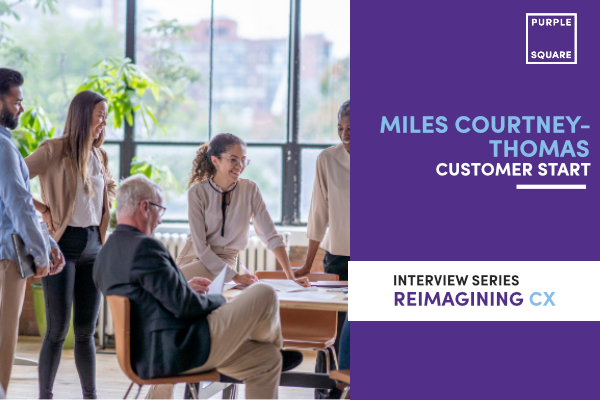Virgin Red’s Dave Robinson on why resolving customer issues may not win you awards but will win you customers.
Purple Square have been speaking to customer experience leaders from top global brands about Reimagining Customer Experience (CX). In this interview Tim Biddiscombe speaks to Virgin Red’s Dave Robinson on why resolving customer issues may not win you awards but will win you customers.
With the help of technology, personalising customer experiences has come a long way, but when it comes to reaching customers at the right time, through the channels they prefer and with service, action and messages that resonate with them, there is still a lot more work to be done.
Getting the basics right
Conversations about customer experience often focus on what brands need to do to ‘surprise’ and ‘delight’ their customers. While there is a time and a place for shine and glitz when it comes to engagement, all too often marketers can fall into the trap of focusing campaigns, experiences and messages on what’s interesting to them, rather than what their customers actually want.
Brands shouldn’t confuse a response of ‘surprise’ or ‘delight’ to a campaign with having all of their ducks in a row when it comes to customer experience.
As Dave Robinson noted, “Marketers can have a tendency to deliver the shiniest stuff, but the basics need to be in place. The task is to make the customer experience better. Sometimes better means flashy, but sometimes better means simpler.”
Even the most outstanding offer or campaign will not make up for a convoluted customer journey. People are busy. They work hard. They want to buy from brands that understand this, reward their loyalty and offer them the support they need if something goes wrong – without needing to jump through countless hoops to get it.
He continued, “I don’t think there’s quite enough work being done on understanding customer journeys – mapping them out and knowing what obstacles brands are presenting to customers and how we can improve them. No one wins awards for untangling customer issues, but if you get this right, you will win customers.”
Leading with data
Data plays a huge role in improving, simplifying and personalising the customer experience.
“I’m a firm believer that where there’s data, better decisions can be made. There’s less guesswork required when there’s data available – whether it’s about where we spend our media investment or understanding our customer journeys better. Leading with data is the key to winning with customers,” explained Robinson.
Data alone is not enough, however. Understanding what data you need and using what information makes sense is essential to avoid hosing yourself down with data until you can’t see the wood for the trees.
He continued: “We should be led by the data, but it is a balancing act. You do need a clear view of your proposition, but I think there’s a lot to be said for letting the data speak for itself. By that I mean start with what the data’s shown you and go from there, rather than starting with a hypothesis. Human nature will lead you to focus on the data that confirms your hypothesis, inevitably leading to confirmation bias.”
For data to truly lead the customer experience it needs to be clean, reliable and complete. Personalising the customer experience requires joined-up data to make it effective.
The human touch
Marketing relies on technology not only for data, but to help it to scale. Getting the balance right between people and tech is essential to create an effective – and personal – customer journey.
Robinson said, “There’s something powerful about human interaction. We used to talk about personalisation as trying to get back to the ‘corner shop experience’, but on a larger scale. In a sense this is what we want to do, but we need technology to get us there.”
In essence, technology should not come at the expense of human interaction. It should enhance the customer experience, not take it over.
He continued: “Rather than feeling inhuman, tech needs to feel like a relationship – doing the tasks that people don’t need to, but leaving room for face to face interaction where it makes sense. For example, an Upper Class flyer expects personal attention when it comes to their flight, but doesn’t need a person to change the phone number on their account.”
Location, location, location
Brands need to understand when, where and how customers are interacting with them. When it comes to the ‘where’ to find customers, so many brands rely on emails to deliver personalised messages to their customers. It’s a known quantity, most people still use it and the technology already exists to simplify the process.
Admittedly, social channels are harder to crack without maxing out resources, but with 59% of the world now using social media, this is a platform that brands need to use more effectively to truly personalise customer experiences.
Robinson noted: “In general, brands don’t use social as a two way communication channel. While some are using it as a way to start conversations, what they haven’t done is to use channels like WhatsApp to talk to customers.”
To truly personalise customer experience, brands need to be reaching customers where they are, where they interact with people, not just where we hope they’ll see us.
Robinson concluded: “Social needs to be developed as a way for customers to have conversations with a business or brand. For them to comment and brands to respond. Admittedly, this does bring complications with workflow, which is why as an industry we still have more work to do.”
“Brands have been talking about personalisation for years, but I feel like they’re just getting started. I still don’t feel like they are talking to ME as an individual. I just received a flyer through my letterbox last week for a service I’ve already signed up for. There is so much more we can do.”
Like what you see?
Subscribe to our newsletter for customer experience thought leadership and marketing tips and tricks.





